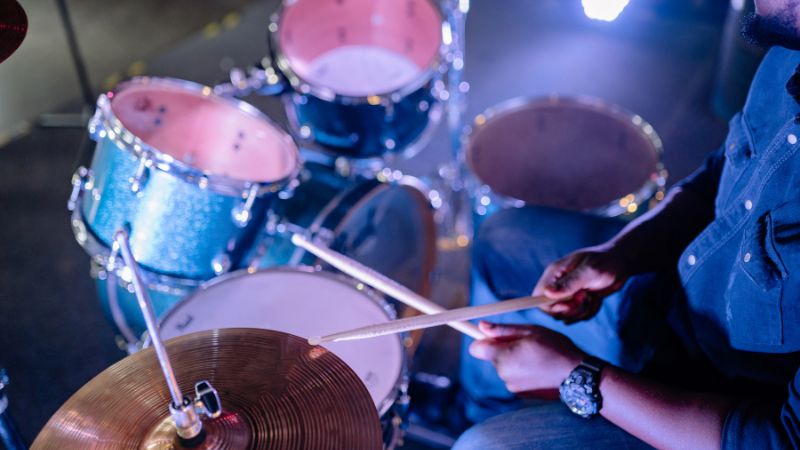Jazz drumming forms the rhythmic backbone of one of America’s most influential musical genres.
This intricate art form combines timekeeping, improvisation, and dynamic control to create the pulsating heartbeat of jazz ensembles.
Jazz drummers employ a wide range of techniques to support and enhance the music, from subtle brush sweeps to explosive solos.
This article will explore the essential elements of jazz drumming, covering fundamental skills, advanced concepts, and practical tips for aspiring jazz percussionists.
We’ll delve into the nuances of swing feel, examine various jazz styles, and provide insights into equipment choices and practice strategies.
By understanding these core principles, drummers can develop the versatility and musicality required to excel in the vibrant world of jazz.
Introduction to Jazz Drumming
Jazz drumming originated in the early 20th century as a fusion of African rhythms and Western musical traditions.
The role of the jazz drummer evolved from simple timekeeping to becoming an integral part of the ensemble’s creative expression.
Jazz drummers must possess a unique set of skills, including impeccable timing, dynamic control, and the ability to improvise.
These musicians serve as the rhythmic foundation while simultaneously engaging in musical dialogue with other band members.
The Fundamentals of Jazz Rhythm
The essence of jazz rhythm lies in its infectious swing feel and syncopation.
Jazz drummers must master the art of subdivision, particularly the triplet-based feel that characterizes swing.
Key concepts include:
- Emphasizing the backbeat beats 2 and 4
- Developing a strong internal clock
- Understanding polyrhythms and cross-rhythms
Table 1: Basic Jazz Rhythm Patterns
| Pattern Name | Notation | Description |
|---|---|---|
| Swing Eighth Notes | ♩♪♪♩♪♪ | Elongated first eighth note, shortened second |
| Charleston | ♩.♪♪♩ | Syncopated pattern emphasizing offbeats |
| Clave | ♪♪♪♩♪♩♪♪♪ | Five-stroke pattern common in Afro-Cuban jazz |
Understanding the Swing Feel
The swing feel forms the cornerstone of jazz rhythm.
This distinctive groove creates a sense of forward motion and excitement in the music.
To master the swing feel, drummers must:
- Internalize the triplet subdivision
- Practice the “ding-ding-a-ding” ride cymbal pattern
- Develop a relaxed, flowing approach to timekeeping
Drummers should focus on maintaining consistent time while allowing for subtle variations that contribute to the music’s overall groove.
Mastering Essential Jazz Drumming Techniques
Jazz drumming requires a diverse set of technical skills.
Essential techniques include:
- Single and double stroke rolls
- Paradiddles and other rudiments
- Brush sweeps and circular motions
- Four-way coordination exercises
These foundational skills form the basis for more advanced jazz drumming concepts.
Regular practice of these techniques will enhance a drummer’s overall control and versatility.

The Art of Brushwork in Jazz
Brushwork adds texture and nuance to jazz performances.
This technique involves using wire brushes instead of traditional drumsticks to create softer, more atmospheric sounds.
Key brushwork skills include:
- Circular sweeping motions
- Tap and lift techniques
- Pressure control for dynamic variation
Mastering brushwork allows drummers to excel in ballads and quieter musical settings, expanding their expressive range.
Developing Solid Timekeeping Skills
Impeccable timekeeping forms the foundation of great jazz drumming.
To develop rock-solid time, drummers should:
- Practice regularly with a metronome
- Play along with recordings of jazz masters
- Focus on consistent ride cymbal patterns
- Develop independence between limbs
Solid timekeeping enables drummers to provide a stable rhythmic foundation while still allowing for creative expression and interaction with other musicians.
Exploring Jazz Drum Set Setup and Equipment
The configuration of a jazz drum set can significantly impact a drummer’s performance.
Key considerations include:
- Cymbal selection and placement
- Drum sizes and tuning
- Throne height and positioning
- Pedal tension and responsiveness
Table 2: Common Jazz Drum Set Configurations
| Component | Traditional Setup | Modern Variation |
|---|---|---|
| Bass Drum | 18″ or 20″ | 16″ or 18″ |
| Snare Drum | 14″ x 5″ wood | 14″ x 5.5″ metal |
| Tom-Toms | 12″ and 14″ | 10″ and 14″ |
| Ride Cymbal | 20″ or 22″ | 21″ or 22″ with rivets |
| Hi-Hats | 14″ | 15″ |

Comping Patterns and Accompanying the Band
Comping refers to the rhythmic accompaniment provided by the drummer to support soloists and maintain the groove.
Effective comping requires:
- Active listening to other band members
- Varied rhythmic patterns on snare and bass drum
- Dynamic control to complement the overall ensemble sound
Drummers should develop a diverse repertoire of comping patterns to suit different jazz styles and musical contexts.
The Role of Dynamics in Jazz Drumming
Dynamic control plays a crucial role in jazz drumming expression.
Mastering dynamics involves:
- Developing touch sensitivity on all drum set components
- Utilizing ghost notes for subtle rhythmic embellishment
- Employing crescendos and diminuendos to shape musical phrases
By manipulating dynamics, jazz drummers can create tension and release within the music, enhancing the overall emotional impact of a performance.
Improvisation and Soloing Techniques for Jazz Drummers
Improvisation lies at the heart of jazz drumming. To develop strong soloing skills, drummers should:
- Study the vocabulary of jazz drumming legends
- Practice trading fours and eights with other musicians
- Develop thematic ideas within solos
- Incorporate rudiments and sticking patterns creatively
Effective jazz drum solos balance technical prowess with musical storytelling, contributing to the overall narrative of a performance.
Jazz Styles: From Swing to Bebop and Beyond
Jazz drumming has evolved through various stylistic periods.
Key jazz styles include:
- Swing: Characterized by a flowing, triplet-based feel
- Bebop: Featuring faster tempos and complex rhythmic interactions
- Cool Jazz: Emphasizing subtlety and understatement
- Hard Bop: Combining bebop complexity with blues and gospel influences
- Modal Jazz: Focusing on extended improvisations over static harmonies
Each style requires specific approaches to rhythm, dynamics, and interaction within the ensemble.
Fusion Drumming: Blending Jazz with Other Genres
Fusion drumming combines elements of jazz with other musical styles such as rock, funk, and Latin music.
Key aspects of fusion drumming include:
- Incorporation of odd time signatures
- Use of extended drum set configurations
- Blending acoustic and electronic percussion sounds
- Emphasis on complex polyrhythms and metric modulations
Fusion drummers must develop a wide range of technical skills to navigate the diverse stylistic demands of this genre.
Essential Warm-up Exercises for Jazz Drummers
Proper warm-up routines prepare drummers for optimal performance.
Essential warm-up exercises include:
- Single and double stroke rolls at various tempos
- Paradiddle variations
- Independence exercises for all four limbs
- Stretching routines to prevent injury
Regular warm-up practice enhances technical proficiency and physical readiness for jazz drumming.

Building Your Jazz Vocabulary Through Listening and Analysis
Developing a rich jazz vocabulary requires extensive listening and analysis.
Drummers should:
- Study recordings of influential jazz drummers
- Transcribe drum solos and comping patterns
- Analyze the interaction between drummers and other musicians
- Attend live performances to observe professional techniques
This analytical approach expands a drummer’s rhythmic and stylistic palette, informing their own musical choices.
Advanced Rhythmic Concepts in Jazz Drumming
Advanced jazz drumming incorporates complex rhythmic ideas to create interest and excitement.
Key concepts include:
- Polyrhythms and cross-rhythms
- Metric modulation
- Displaced rhythms and hemiolas
- Odd time signatures and mixed meters
Mastering these concepts allows drummers to add sophistication and depth to their playing, elevating their contributions to jazz ensembles.
Developing Independence and Coordination
Independence and coordination form the cornerstone of advanced jazz drumming.
These skills enable drummers to create complex, multi-layered rhythms while maintaining a solid groove.
Key aspects include:
- Four-way coordination between all limbs
- Ostinato patterns with improvised variations
- Ability to play in different time feels simultaneously
- Separation of ride cymbal patterns from comping figures
List of essential independence exercises:
- Basic coordination patterns e.g., jazz ride pattern with hi-hat on 2 and 4
- Three-limb ostinatos with one limb improvising
- Linear drumming exercises
- Polyrhythmic independence drills
Regular practice of these exercises enhances a drummer’s ability to execute complex ideas while maintaining a strong rhythmic foundation.
Practice Strategies for Improving Your Jazz Drumming
Effective practice accelerates skill development in jazz drumming.
Optimal practice strategies include:
- Structured daily routines covering technique, timekeeping, and creativity
- Slow-to-fast method for mastering complex patterns
- Recording and self-evaluation of practice sessions
- Focused work on specific weaknesses or goals
Table 3: Sample Jazz Drumming Practice Routine
| Time | Activity | Focus |
|---|---|---|
| 15 min | Warm-up | Rudiments, stretching |
| 20 min | Technique | Stick control, brush patterns |
| 30 min | Timekeeping | Ride cymbal consistency, comping |
| 20 min | Style study | Specific jazz style or drummer |
| 15 min | Improvisation | Solo ideas, trading fours |
| 20 min | Transcription | Analyzing recorded performances |
Consistent, focused practice yields steady improvement in all aspects of jazz drumming.

Choosing the Right Drumsticks and Brushes for Jazz
Selecting appropriate drumsticks and brushes significantly impacts a jazz drummer’s sound and feel.
Considerations for choosing best drumsticks for jazz include:
- Weight: Lighter sticks for faster playing, heavier for more volume
- Tip shape: Wood tips for warmer tones, nylon for brighter sounds
- Length: Longer sticks for reach, shorter for control
- Material: Hickory for durability, maple for lighter weight
For brushes, options include:
- Wire brushes for traditional jazz sounds
- Nylon brushes for increased durability
- Combo brushes with both wire and nylon bristles
The right tools enable drummers to achieve their desired sound across various jazz contexts.
Famous Jazz Drummers and Their Contributions
Studying legendary jazz drummers provides invaluable insights into the evolution of the art form.
Notable figures include:
- Baby Dodds: Early jazz pioneer who helped establish the drum set’s role
- Gene Krupa: Swing era star who brought drumming to the forefront
- Max Roach: Bebop innovator known for melodic solos and advanced compositions
- Art Blakey: Hard bop master famous for his powerful, driving style
- Elvin Jones: Polyrhythmic genius who redefined jazz time feel
- Tony Williams: Fusion pioneer who pushed the boundaries of jazz drumming
Each of these drummers made unique contributions to the language of jazz percussion, influencing generations of players that followed.
Resources for Continued Learning and Growth
Ongoing education plays a crucial role in a jazz drummer’s development.
Valuable resources include:
- Method books e.g., “The Art of Bop Drumming” by John Riley
- Online video lessons and masterclasses
- Jazz workshops and clinics
- Play-along tracks for practice
- Jazz drumming forums and online communities
List of recommended jazz drumming books:
- “Advanced Techniques for the Modern Drummer” by Jim Chapin
- “The Jazz Drummer’s Workshop” by John Riley
- “Future Sounds” by David Garibaldi
- “Stick Control” by George Lawrence Stone
- “The Drummer’s Complete Vocabulary” by Alan Dawson and John Ramsay
These resources provide structured guidance and inspiration for drummers at all levels of proficiency.
Conclusion
Mastering jazz drumming requires dedication, creativity, and a deep understanding of musical tradition.
By focusing on fundamental techniques, developing a strong sense of time, and cultivating improvisational skills, drummers can contribute meaningfully to the rich tapestry of jazz music.
The journey of a jazz drummer is one of constant growth and exploration, with each performance offering new opportunities for expression and innovation.
As drummers continue to push the boundaries of rhythm and interaction, they ensure that the vibrant legacy of jazz drumming will continue to evolve and inspire future generations of musicians.
